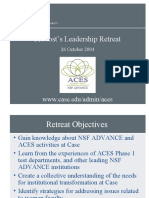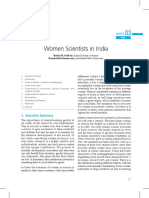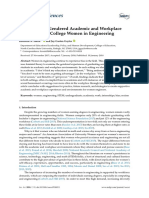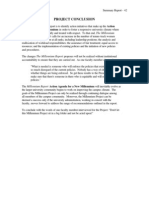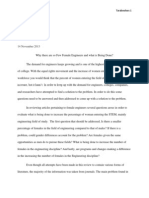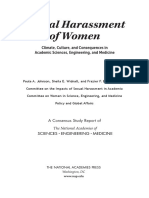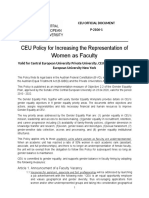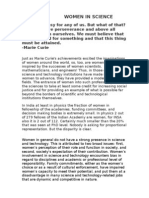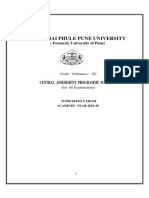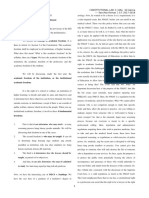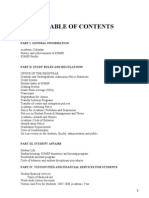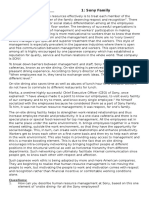Society of Engineers
Uploaded by
mercurycrossroadsSociety of Engineers
Uploaded by
mercurycrossroadsReport of
the School of
Engineering
Reports of the Committees on the
Status of Women Faculty
March 2002
Massachusetts Institute of Technology
Statement from the Dean of the School of Engineering
Embracing Gender Diversity
For most of history, Anonymous was a woman.
Virginia Woolf
In my youth, I was surrounded by engineers. My father worked for the engineering
division of a large chemical company and I had many opportunities to watch him and his
colleagues at work and at play. I have long held two impressions of those days. First,
engineering seemed exciting: engineers were developing new chemicals, introducing new
processes, and launching new equipment, new plants, and new products. They had
opportunities to work on interesting, challenging problems. They were truly engaged in
their work and seemed to be having fun. My second impression was that engineering was
for everyone. I saw no barriers. If you had talent, interest, and the right training, then
engineering could be for you.
Now as I look back on those days, I realize that I was wrong. Not about engineering
being exciting. It was exciting then, and it is even more exciting now. But engineering,
it seems, was not for everyone. All the engineers I knew were white men. Clearly,
barriers did exist.
Today engineering does attract women and it does attract minorities, but not enough of
either. Barriers persist and all too many of us remain oblivious to them.
In the wake of the noted MIT Women Faculty in Science report, in the Fall of 1999 I
convened a similar committee to assess the situation in engineering. The enclosed report
summarizes the Committees findings. Some of these findings are heartening. MIT
engineering has about sixty-five percent more women undergraduate students, twenty
percent more women graduate students, and twice the fraction women faculty as the
national average. Women faculty performance is comparable to that of men (e.g., tenure
rates, time to promotion, percentage of faculty with chairs). Women are compensated
equally with men.
But some of the Committees other findings are very disturbing. Many of our women
faculty, and especially the senior women, feel marginalized. We learn, for example,
about some of our women faculty colleagues, who despite their superb professional
standing and despite the fact that they are highly valued by their faculty colleagues, have
never been asked to serve on the Ph.D. committee of even one of their colleagues
students in their own research area. Stunning. We learn that women faculty candidates
reject a far greater percentage of our faculty offers than male candidates. And, we learn
that on a percentage basis, we make about half as many offers to our female Ph.D.
graduates as we make to our male Ph.D.s. In sum, we learn that there is bias and that
MIT is not a hospitable environment for many women faculty.
Simply put, this situation is unacceptable. The strongest, most resilient human systems
exhibit the highest degree of freedom, opportunity, and diversity. For the sake of the
engineering profession, for MITs sake and, quite simply, because it is the right thing to
do, we should and we must do better. I ask each of my male colleagues at MIT and
elsewhere to try to put themselves in the position of our women colleagues. How would
you react in similar circumstances? How would you feel about your environment if you
were subjected to such behavior? What kind of signals would you be sending to your
students if you felt thus marginalized?
In the past decade we have doubled the percentage of women faculty in engineering at
MIT. I am firmly committed to doing so again in the decade ahead. I am also committed
to making MIT a more welcoming environment for women faculty. We need to educate
ourselves about the current situation and about the gender biases that we all hold, women
and men alike. We need to put in place administrative processes to promote the
objectives we seek and to monitor our progress. But, most importantly, we need to
ensure that developing a more diverse community, in both gender and race, remains a
high priority. We have begun down this path, but we have much more to do.
In closing, I would like to thank the members of the Committee on Women Faculty in
Engineering, and especially its chair, Professor Lorna Gibson, for the significant time and
energy they have devoted to this important task and for the forward looking, constructive
perspective that has characterized our interactions during the development of the report.
You have done an enormous service for the School and Institute and, I hope, more
broadly for the academic engineering enterprise.
Thomas L. Magnanti
MIT Dean of Engineering
January 15, 2002
REPORT OF THE COMMITTEE ON WOMEN FACULTY
IN THE SCHOOL OF ENGINEERING
AT MIT
March 2002
Mary C. Boyce
Penny Chisholm
Edward F. Crawley
Lorna J. Gibson (Chair)
Karen K. Gleason
Nancy A. Lynch
John B. Vander Sande
______________________________________________________________________
This report was written with the assistance of Martha Nichols.
EXECUTIVE SUMMARY
Academic leadership can both implement policy changes as well as foster a change in the
culture of the institution. Following the 1999 publication of the report on gender inequities in
MIT's School of Science, the Dean and senior administration at MIT not only acknowledged the
problems but addressed them in concrete ways.i In addition, the President and Provost called for
the formation of similar committees in the other four Schools at the Institute (Architecture and
Planning; Engineering; Humanities, Arts and Social Sciences; and Management) and the Provost
created a Council on Faculty Diversity.
The Committee on Women Faculty in the School of Engineering was asked to assess the
status and equitable treatment of women faculty in the School through data collection and
interviews. The Committee found similar patterns to those described in the School of Science
report: low numbers, past salary discrepancies, marginalization and problems in balancing work
and family responsibilities.
This report summarizes the findings of the Committee and the institutional changes that
MIT is implementing to address the issues.
Faculty Hiring and Retention
The percentage of women faculty in the School of Engineering increased from 5 percent in
1990 to 10 percent in 2001. While the percentage has doubled, it is still small. Overall, hiring in
the School has been in line with the percentage of women awarded PhDs in engineering at our
peer institutions, from which MIT hires.
The Dean of Science, working with the Department Heads, took action to address the
findings of the Committee on Women Faculty in the School. He hired more women
faculty (increasing the percentage from 8 to 13 percent), increased the salaries of some
women faculty and addressed individual issues of space, resources and outside offers.
The inclusion of women in influential departmental activities has also increased.
2
The committee found two particular areas of concern with regard to hiring:
The two largest departments in the School, which account for half the faculty, had
a net gain of only two women over almost a decade. Between 1990 and 1998 one
of these departments hired 28 men and 0 women. The other department lost one
of the two women it hired in the late 1980s and failed to retain any of the other
three women hired during the 1990s.
There were disparities in the hiring patterns between men and women: for
instance, men with PhDs from MIT were hired onto the faculty at almost twice
the rate as women with PhDs from MIT.
There are some signs of progress: the number of women faculty has increased from 31 in
1999 to 34 as of September 2001. Three additional women have already accepted faculty
positions to begin during the 2002 calendar year; one of these is tenured. The department that
hired no women over an 8-year period has hired 3 women since 1999, two with tenure. In
addition, the tenure rate and time for promotions are similar for women and men.
In response to the Committee's findings, the Dean of Engineering has enforced the
affirmative action policy more strictly, personally reviewing applications from women candidates
and turning back proposals to hire specific candidates from departments that have not searched
sufficiently for women or given appropriate consideration to women candidates. The Dean has
also agreed to a target of women making up 20 percent of the faculty in the School of Engineering
by 2010.
The Council on Faculty Diversity is developing guidelines for faculty searches outlining
appropriate search procedures. The Provost has developed standards for faculty searches that
include diversity on the search committee, broad searches and justification of the candidate
selection (including describing the relative merits of the candidates, especially women and
minorities). The Provost's standard indicates that searches that identify no women or minority
candidates should be viewed skeptically by the Dean.
Compensation
The salaries of women and men on the faculty in Engineering are comparable at the lower
ranks. A number of senior women report experiencing unexplained salary jumps at various times
which they believe were made to make up for past inequities. (It appears that small differences,
compounded over a number of years, produce differences that are large enough to be noticed and
are then corrected.) Faculty salaries are now being reviewed by one or more members of the
Committee on Women Faculty in each School.
Compensation also includes benefits. The very different demographics of the women
faculty lead to inequitable subsidy of benefits such as health insurance and the Children's
Scholarship Program that provides tuition for the children of faculty. One potential benefit that
many women faculty need and is not currently subsidized is child care. The Council on Faculty
Diversity is planning to review options for modifying the benefits plan.
Marginalization
Marginalization is manifested in a variety of ways. In our interviews with women
faculty, we heard of women not being included in research activities (e.g., participation in group
research grants or PhD thesis committees) and in departmental activities (e.g., women never being
invited to give a presentation at annual departmental retreats; lack of representation on influential
committees). Some women noted that they were asked to teach lower level undergraduate
subjects rather than specialized graduate subjects relating to their own research. Some were asked
to change their teaching assignments more often than their male peers. A few women reported no
feelings of marginalization; they felt that they had been appropriately included on key
committees. One woman in particular felt that MIT worked hard to give her more opportunities
for visibility than her male counterparts.
Marginalization also compounds over time: for instance, women who are not invited to
be on influential departmental committees do not develop the experience needed to move on to
higher level administrative positions. At the start of the study the Committee found that there
were few women in line academic leadership positions - with only one woman on the Engineering
faculty in such a position (and that program was not in the School of Engineering). Currently,
4
there are three women in Engineering in line academic leadership positions. In addition, three
women on the Engineering faculty now have non-line positions with substantial administrative
responsibility.
The role of the Department Head in ensuring that women participate fully and fairly in
the departmental activities is crucial. Addressing the marginalization issue is perhaps the most
difficult of all as it occurs on the level of individuals, in many cases unconsciously. As one step,
the Dean is sponsoring a workshop on gender schemas and marginalization of women for
Engineering Council (made up of all the Department Heads and the Directors of some of the
larger Centers in the School). The Council on Faculty Diversity is considering ways of
addressing marginalization.
Work and Family Issues
Almost all of the women we interviewed spoke of the difficulties in balancing work and
family responsibilities. Roughly half of the women faculty in the School of Engineering do not
have children; among the tenured women faculty the percentage decreases to about 40%. About
20% of the men on the faculty at MIT reported that they did not have children in the last MIT
survey on family and work. At the time the Committee began its study, family leave policies
varied throughout the Schools at MIT. In Engineering, faculty were allowed one semester release
from teaching and administrative duties at full pay to spend time at home caring for a new child.
In December of 2001, MIT adopted two policies designed to address some of the issues
associated with balancing work and family: extension of the tenure clock for childbearing (and, by
request, for adoption) and part-time appointment with tenure for family care. MIT is also
increasing the on-site day care facilities: the new child care center in the Stata Center currently
being constructed will accommodate 73 children beginning in January 2004, to bring the total
number of day-care slots to 132.
INTRODUCTION: How the Committee Formed and Why Its Findings Matter
"A number of my colleagues dismissed the value of my work even though it was
crucial to the work of other faculty." --- Comment from a senior woman on the faculty.
In March of 1999, the Committee on Women Faculty in the School of Science
published a report in the MIT Faculty Newsletter describing their study on gender
inequities in that School and the response of the MIT administration to their findings. At
a meeting of the women faculty in the School of Engineering shortly after the Women-inScience report was issued, the vast majority of participants called for a similar
investigation into the status of women faculty in the School of Engineering. The Dean of
the School, Thomas Magnanti, approved such a study and in the fall of 1999, the
Committee on Women Faculty in the School of Engineering was formed. The findings of
that study, as well as MIT's efforts to address the gender inequities uncovered, are
summarized in this report. The Committee was asked to assess the status and equitable
treatment of women faculty in the School through data collection and interviews; to make
proposals to increase the proportion of women faculty in the School; to act as a resource
for the Dean of Engineering and department heads on issues that concern women faculty
in the School; and to act as a resource for the MIT community about these issues for the
Institute at large. Of the seven Committee members, five are tenured women faculty from
five of the eight departments in the School of Engineering; two are tenured male faculty
who are current or former administrators in the School.
In brief, the findings of the Committee reinforce those of the Women-in-Science
report. Consider the following examples:
The two largest departments in the School of Engineering , which account for
about half of the faculty in the School, had a net gain of only 2 women faculty
between 1990 and 1999.
6
From 1990 to 1998, one department hired 28 men and no women.
In another department, women are rarely on faculty search committees; a
female professor in this department reported that during faculty searches, she
was only asked to talk with a candidate if that person was a woman.
When we started our study in 1999, there was only one woman faculty
member in the School of Engineering in a line position of academic
administrative leadership and she ran a program that was not in the School of
Engineering. The only other woman who had ever held a line position of
academic administrative leadership in the School of Engineering did so in the
early 1970s.
There is evidence that inequities in compensation for women faculty existed in
the recent past. Over half the women full professors received substantial
increases in their salary following a request for a salary review in 1995.
Women faculty still receive substantially less subsidy of their benefits than
male faculty.
Most important, just 10% of the School of Engineerings 2001 faculty are women.
These low numbers mean women faculty remain outsiders or tokens in their departments.
Yet this is not just a pipeline problem. The Committee also found that a much higher
percentage of female job candidates reject offers to come to MIT - 40% of women as
compared with 14% of the men offered jobs. Given MIT's status as one of the premier
research universities in engineering in the world, these results are disturbing.
In November 2000, the Committee submitted its first confidential report to the
Dean and other administrators. The report included recommendations for hiring of
women faculty, increasing the number of women faculty in academic administrative
leadership positions, ensuring equity in compensation, improving the environment for
women faculty and addressing family/work issues. By that time, positive changes to
address gender inequities were already underway. For instance, a number of women in
the School of Engineering had already received salary adjustments. Dean Magnanti
insisted that qualified women be considered during faculty searches and urged
departments to nominate women faculty for awards. Since the November 2000 report,
the administration has begun acting on a number of the recommendations. Here, we
summarize the findings of the committee, list the recommendations and describe the
progress made to date in implementing them. Gender inequities that have existed for
decades are difficult to eradicate without an institution's sustained commitment over
many years. Still, documenting what has occurred is a useful place to start, and can lead to
the kinds of changes that eventually create an equitable working environment for all.
BACKGROUND: WOMEN IN SCIENCE LEAD THE WAY
The discrepancies in treatment of male and female faculty have much more to do
with small, unconscious biases than blatant sexism. In many cases, male faculty are
simply unaware of the ways in which these inequities occur on a daily basis for their
female colleagues. Yet there is strong evidence that they do occur.
The main finding of the 1999 Women-in-Science report, which was based on data
and interviews with women faculty and department heads gathered over the previous four
years, was a progressive marginalization of women faculty members in the School of
Science as as they moved through their careers. According to the report, marginalization
during the period studied was often accompanied by differences in salary, space, awards,
resources and response to outside offers between men and women faculty with women
receiving less despite professional accomplishments equal to those of their male
colleagues.
The findings presented in the Women-in-Science report, as well as those for the
School of Engineering, are consistent with a number of studies documenting how women
are undervalued in academia. Virginia Valian's (1998) book Why So Slow? describes the
ways in which gender schemas, or implicit hypotheses about sex differences, lead to
inequities in the evaluation of the accomplishments of men and women. Even small
differences in evaluation and treatment effectively compound over the course of a
career, leading to large disparities for individuals at later stages in their careers.
Take one recent study, in which a curriculum vita was distributed to two groups
of faculty from the same field throughout the United States who were then asked if they
would hire the candidate (Steinpreis et al., 1999). Both groups had similar numbers of
male and female faculty. All copies of the curriculum vita were identical, except that half
had a man's name while the other half had a woman's. Fewer than half the faculty who
reviewed the woman's curriculum vita said she should be hired, while nearly threequarters of the faculty who reviewed the mans curriculum vita said he should get the job.
Strikingly, it wasn't just the male faculty members who favored the male candidate. There
was no statistically significant difference in the evaluation of the curriculum vita by male
and female faculty. These and many other studies demonstrate the power of unconscious
bias in evaluation processes, with bias usually working to the disadvantage of women.
Given how endemic such biases are, the efforts of the MIT administration to
address gender inequities, as well as the impetus provided by the Committee on Women
Faculty in the School of Science, are notable. The Women-in-Science report has had a
remarkable impact. At MIT, the Provost, in collaboration with the Deans, supported
similar gender equity committees in the other four Schools, including this committee in
Engineering. In addition, the President established a Council on Faculty Diversity to
address issues pertaining to the under-representation of both women and minorities on
the MIT faculty. Professor Nancy Hopkins, the first Chair of the Women-in-Science
committee, has been appointed Co-chair of the Council on Faculty Diversity and now sits
on Academic Council. The Women-in-Science report has also had a broader impact
outside of MIT, generating widespread press. A number of other institutions are now
undertaking their own gender-equity studies. Professor Hopkins has given talks on
gender-equity issues at dozens of universities, at the White House and at the California
State legislature.
As the Women-in-Science report emphasizes, This collaboration of faculty and
administration could serve as a model for increasing the participation of women, and also
of under-represented minorities, on the faculty of other Schools at MIT. This is an
important initiative since, even with continued effort of this magnitude, the inclusion of
substantial numbers of women on the Science and Engineering faculties of MIT will
probably not occur during the professional lives of our current undergraduate students.
On reading the Women-in-Science report, MIT President Charles Vest commented "I
have always believed that contemporary gender discrimination within universities is part
reality and part perception. True, but I now understand that reality is by far the greater
part of the balance."
THE FINDINGS IN ENGINEERING: Low Numbers Underlie Other Problems
The Committee on Women Faculty in the School of Engineering completed its
study in November 2000. The Dean's office provided extensive personnel data, allowing
committee members to examine the number of degrees granted to women and men, number
of female and male faculty, hiring of faculty, years from doctorate to tenure decision,
tenure success, time for promotion, compensation, and committee assignments. Most of
the data covers the 1990s, but some go back as far as 1981. During the course of the
study, committee members interviewed almost all of the female faculty members in the
School of Engineering. Since November 2000, the Committee has updated certain figures,
and the most recent available appear in this report.
The Committee's quantitative findings are summarized below, including the
number of women faculty, hiring patterns, women in academic leadership positions,
promotion and tenure, compensation, benefits/demographics, and outside professional
activities. The interviews conducted with women faculty provide additional qualitative
findings.
10
Numbers of Women Faculty
In July 1990, there were 17 female professors with primary appointments in the
School of Engineering out of a total of 357 faculty, or 4.8% women. As of September 1,
2001, there are 34 female faculty out of a total of 348, or 9.8%. Although this doubles
the percentage, the number of women faculty remains strikingly low. The conventional
explanation for the scarcity of female faculty in the male discipline of engineering is that
not enough qualified female candidates are in the pipeline. Yet the pipeline is growing, at
least in a limited fashion. For instance, at MIT the percentage of PhD degrees in
engineering awarded to women grew from 13% in 1990 to 18% in 2000, averaging 15%
over that period (Fig. 1). The fraction of PhD degrees awarded to women at peer
institutions, such as Stanford, Berkeley, and Caltech, was similar in 2000 (18-21%).
Hiring of women faculty in engineering at MIT has been consistent with these
numbers: 14% of the faculty hired between 1990-1999 were women. However, closer
examination of the data reveals variability between departments. From 1990-1999, there
was a net gain of 12 women faculty in the School of Engineering. During this period,
three mid-sized departments (Chemical, Civil and Environmental, and Materials Science
and Engineering) accounted for 9 of the net gain of 12 women faculty in the School. All
three department heads made a commitment to hiring women faculty. But the two largest
departments, Electrical Engineering and Computer Sciences (EECS) and Mechanical
Engineering (ME), which together account for roughly half the faculty in the School,
added only 2 of the net gain. The percentage of PhD degrees awarded to women in these
two fields in 2000 at MIT, Berkeley and Stanford, the schools from which MIT's School
of Engineering hires most of its faculty, was 14% and 16%, respectively. Between 1990
and 1998, EECS hired 28 men and 0 women. Within EECS, faculty are associated with a
Laboratory; the Laboratory for Computer Science did not add any women in EECS
between 1983 and 1999. It should be noted that the situation in EECS has improved
considerably since 1998. Three women have recently been hired, two tenured and one
11
untenured. A fourth woman recently transferred from another department to EECS.
In Mechanical Engineering, however, while women have been hired onto the
faculty, only one of the five ever hired up until 2001 is still at MIT. The first woman was
hired by the department in 1987 and is now a full professor with an endowed, 5 year,
chair in the department. All of the other four women hired between 1987 and 2000 have
left MIT. Mechanical Engineering hired another woman faculty member in 2001.
Hiring Patterns
In addition to low numbers and variable hiring rates in departments, the
Committee found a number of gender-based differences in the hiring pattern of faculty
within the School of Engineering. Between 1986 and 2000, 64% of the men hired obtained
their PhDs at MIT, Stanford, or Berkeley, while only 33% of the women hired obtained
PhDs at these three schools. The data suggest that the School is much less successful in
recruiting women than men from top engineering schools.
The discrepancy between male and female MIT PhDs who are hired by the School
is particularly telling. Between 1986 and 2000, 43% of the men hired had MIT PhDs,
while only 21% of the women did. Between 1990 and 1999, the School of Engineering
granted 2,025 PhD degrees to men; 40 of these men were hired as faculty, representing
2.0% of the pool of male PhDs. During the same period, MIT granted 351 PhDs degrees
to women; 4 of these women were hired as faculty, representing 1.1% of the pool of
female PhDs. While the School of Engineering's overall hiring rate for women matches the
national percentage in the pipeline (14%), the School is not taking advantage of the
available pool of women within MIT.
The Committee also compared the acceptance rates of faculty offers for men and
women. Between 1981 and 1999, 14% of the men and 40% of the women rejected an
offer of a faculty position at MIT: women reject our offers at almost 3 times the rate that
men do. For example, during the 1990-1998 period when no women were hired in EECS,
12
four offers were made to female candidates but all were rejected. Clearly, MIT faculty
positions are less attractive to women than to men. In fact, very few of the women
currently on the faculty who did their PhDs here were initially enthusiastic about joining
MIT. One told the Committee "when I finished my PhD at MIT, I didn't think of
becoming a professor: my academic advisor looked too stressed out and I didn't want an
academic job initially". Interviews with the women faculty suggest a number of reasons
why: family considerations, problems with relocating because of a partner's career, the
high stress associated with an MIT faculty position, and the difficulty in collaborating
with colleagues at MIT. More research is needed to understand what role outside societal
factors, as well as internal MIT factors, play in candidates' decisions to accept or reject
faculty positions at MIT.
Women in Academic Leadership Positions
When the Committee's study began in the fall of 1999, only one woman in the
School of Engineering held a line academic administration position and that woman was
co-director of a program that was not in the School. These positions include the Provost,
Deans, Department Heads, and some Lab and Center Directors. That one woman made
up 2.6% of these positions at a time when 6% of the full professors in engineering were
women.
In the last two years, however, the number of women in such academic leadership
positions has increased dramatically. Three currently have line academic administration
positions. Two now sit on Engineering Council and one sits on Academic Council. In
addition, three other women in the School have been appointed to positions with
substantial administrative responsibilities.
Promotion and Tenure
The pattern of promotion and tenure for women on the engineering faculty is
13
similar to that for men. From 1986 to 2000, the length of time from PhD degree to a
tenure decision was 9.4 years for men and 9.2 years for women. The tenure success rate is
also similar: 46% of men and 50% of the women hired between 1977 and 1993 in the
School were tenured. In addition, women are promoted to full professor more quickly
(4.3 years for women versus 5.4 years for men).
Compensation: Salary
The Committee had access to a plot of salary versus age, by gender, indicating the
different ranks of faculty. On average, the salaries of male and female faculty were similar
at a given rank. However, the Committee noted that a number of corrections had already
been made to women faculty's salaries. In late 1995, the tenured women had concerns
about salary inequities and requested a salary review. Data for the percentage increases of
the women who were full professors (in departmental faculty, rather than in line academic
administrator, positions) from 1990-1999 indicated that over half of them had received
significant increases in their salaries in the two subsequent years. In addition, a more
detailed review of the salaries of individual women and men of similar rank and age by the
Chair of the Committee and the Dean in the spring of 2000 resulted in a small number of
women, at various levels, receiving additional salary increments.
Several of the more senior women on the faculty indicated that at various times in
their careers at MIT they had received substantial increases in their salaries, or "out-ofseason" increases not associated with a promotion or tenure which were thought to make
up for past inequities. For example, this committee had access to one female full
professor's salary increases over the course of more than 20 years. The data indicate that
she received a 17% increase the year she was promoted from Assistant to Associate
Professor, including the additional salary increment (typically 7%) associated with the
promotion. The following year, when there was no raise associated with promotion, her
salary increased by 16%. The same pattern occurred at promotion from Associate to Full
14
Professor: the year of the promotion her raise was 16% and the following year it was
15%. Later on in her career, she received an "out-of-season" raise, mid-year, out of the
normal salary cycle. A second senior woman told us that at three times in her career she
had also received remarkably large increases in her salary, which she thought were to make
up for past inequities.
Together the data suggest that salary inequities have occurred in the School of
Engineering. The need for sudden corrections could be due to the chronic undervaluation
of female faculty. The correction is made when someone, such as a new department head,
notices a discrepancy. This represents good faith on the part of MIT, but individual
salary adjustments do not address all discrepancies in compensation, nor do they account
for the full loss of salary (eg. backpay, retirement contributions).
Compensation: Benefits and Demographics
In 1989, 82% of the male MIT faculty had children compared with 53% of the
female faculty (Final Report of Ad Hoc Committee on Family and Work, 1990) . As of
Spring 2000, 52% of the School of Engineering's female faculty had children - essentially
no change from the Institute's percentages of ten years before - and the number goes down
to 42% for the School's twelve untenured women. (The U.S. Census Bureau reports that
nationally 82.5% of women aged 40-44 have borne a child). While MIT's current
benefits plan was designed for the traditional family and addresses their needs extremely
well, it does not do so for many women faculty.
Data for two benefits illustrate the situation. In 2000, MIT subsidized medical
insurance by roughly $1,900/year for an individual subscriber and $4,700/year for a
family. In 2000, 49% of the women faculty were individual subscribers (compared with
21% of the men); 35% of the women faculty were family subscribers (compared with
72% of the men). In addition, 17% of the women faculty (compared with 7% of the men)
didn't make use of the medical benefit at all, presumably because they were insured under
15
the plans of spouses or domestic partners. The net effect was that, on average, men were
subsidized $1,400/year more than women. (Fig. 2).
Another benefit, the Children's Scholarship Program, contributes to college tuition
for children of faculty. Institute-wide data provided by the benefits office indicate that in
a typical year, male faculty receive 97% of this benefit. Note that the amount of the
subsidy is quite significant: for example, a faculty member with two children who attend
four year college or university programs, can expect to receive over $100,000 tax-free
towards the cost of tuition over the time the children are in college or university.
As described above, the demographics of the women differ from those of the men
on the faculty; consequently, the current benefits package doesn't meet their needs as
well. A number of companies and institutions have instituted a cafeteria-style benefits
programs to rectify inequities in benefits options. A single professor with no children, for
example, might choose to use more of her benefits points for her pension plan, improved
disability coverage; or reduced health insurance premiums. Other women might use their
points for mortgage/rental subsidies or child carebenefits options that don't currently
exist at MIT. Faculty members with families could continue to spend their points on
family health insurance, tuition assistance, or other benefits that are now part of the
Institute's program.
Outside Professional Activities
Salary and benefits provide the bulk of faculty compensation, but in the School of
Engineering access to outside consulting work and start-ups can also make a significant
difference. The Committee's analysis shows that the compensated outside professional
activities of male professors increase steadily with rank, and that at all ranks male
professors do more compensated outside professional activities than female professors.
At the assistant professor level, there is a factor of 8 difference in the number of days of
outside professional activity between men and women while at the full professor level,
16
there is a factor of over 4.5 difference.
Consider also the disparity between how much time male and female faculty
spend on uncompensated outside professional activity (such as professional society
committees and panels). In 1999, the number of days of uncompensated outside
professional activity that female faculty performed increased steadily with rank. The
number of days of uncompensated outside professional activity that male faculty
performed remained constant for all ranks. Female faculty did less uncompensated
outside professional activity than male faculty at the assistant professor rank, but did
more at the full professor rank. In summary, senior male faculty spend more time doing
compensated outside professional activity than female faculty while senior female faculty
spend more time doing uncompensated outside professional activity than male faculty.
DISCUSSION: HOW AND WHY WOMEN ARE MARGINALIZED
"I was humiliated by my department head at a department meeting. I received the lowest
raise in the department in spite of my research going extremely well and receiving a
national research award."-- Comment from a senior woman on the faculty.
This woman faculty member is not alone in feeling ill used by her department or
simply ignored. Professional marginalization is insidious, because it so often sounds like
complaints about an individual's specific situation. Yet the cumulative impact of the
Committee's interview data is strongly suggestive, demonstrating a consistent pattern of
marginalization for many of the women faculty in the School of Engineering.
Professors naturally want to work with students and colleagues they're
comfortable with, and in the traditionally masculine world of engineering, that often
means other men with similar backgrounds. Senior male professors tend to take young
men under their wings, providing mentorship and access to informal research networks.
The result of such natural affinities, however, is that people who seem different - women
17
and minorities - remain outsiders.
For example, several women professors noted that male faculty who had done
their PhDs at MIT got more assistance from their former advisors and PhD committee
members. Help from their academic parents yielded research contracts and consulting,
introductions to influential colleagues, nominations for awards, and protection from
unusual teaching and service commitments. Since a far lower percentage of women with
MIT PhDs ends up on the faculty in the School of Engineering, fewer women have the
same access to academic parents or such informal mentoring networks. It's also striking
that four of the six women with MIT PhDs hired from 1986 to 2000 told committee
members "I was on my own."
This section discusses the School's academic environment, connecting the
Committee's quantitative findings with the individual stories gleaned from interviews. For
example, the increasing number of women in academic leadership positions is encouraging,
helping to ensure that the concerns of women faculty are considered. Also, once women
accept faculty jobs at MIT, they appear to be treated equitably during the formal
promotion and tenure process. But the continued low number of women faculty in the
School means that female professors often remain isolated; there isn't the critical mass of
women in place to change the current work culture, and that culture appears to drive
away some promising female candidates. Trouble spots for women faculty include uneven
teaching loads and participation in committees; exclusion from participation in research
activities with colleagues; lack of mentorship; and work/family issues.
Academic Duties: Research, Teaching Loads, and Committees
Many women faculty interviewed reported problems in setting up and running
their research programs, in part because they were not invited to participate in the
research activities of male colleagues. Three women full professors said they had not been
asked to be on PhD students' doctoral committees in their own research areas within their
18
departments. This marginalizes women by sending a subtle message of lack of respect to
women faculty which also permeates into the graduate student population. Some women
commented that they had not been asked to participate in group research grants; exclusion
of women from PhD thesis committees means that in some cases, women are not at the
table when ideas for new research grants are discussed. Several women have not taught
graduate subjects in their own areas, an important step in building a research group. One
woman turned down a faculty offer in large part because of her perception that MIT is
not conducive to collaboration. People didn't want to work with her here, while they were
eager to do so at peer institutions. In contrast, another woman accepted a position at
MIT because of the spirit of collaboration that she perceived at MIT.
Some women in the School of Engineering were also concerned about the number
of different subjects they were asked to teach; many believed they have taught more
undergraduate than graduate subjects compared with their male colleagues. The evidence
for such discrepancies is anecdotal but compelling. One woman reported teaching a
subject with a hundred students along with her regular teaching load; later, when a male
colleague taught the same subject, he was allowed to do so in lieu of his regular load.
In one department, numerous problems in teaching assignments were noted. A
junior woman has taught seven different subjects in seven years; when senior men went
on sabbatical, she was asked to teach their subjects. A senior woman in the same
department taught one of the core undergraduate subjects, as well as three new subjects in
three consecutive years when colleagues were on sabbatical or left the department. When
she brought this up with her department head, he said he didn't see anything wrong with
it. Another woman taught four subjects in a single year while the usual teaching load was
two subjects a year.
There was a common feeling among many, but not all, of the senior female faculty
that they were not asked to be on influential committees in their department. In one
department, presentations at departmental retreats are only given by men, including junior
19
men who have been in the department less than two years. None of the women, including
the senior women, has ever led a discussion at one of these retreats. When one woman
suggested inviting a woman to speak at a department-sponsored special symposium with
international invited lecturers, the women faculty were told that there were no women
anywhere in the world sufficiently qualified to speak at the event. One woman reported
that she was included on influential committees in her department, but felt that her
contributions to those committees were not valued. In contrast, one woman thought that
not being assigned to committees was a positive thing, giving her more time to focus on
other activities; she felt that she had input on important departmental decisions by
making suggestions to committee members.
Exclusion of female colleagues from collaborative research activities and influential
committees, as well as disproportionate teaching assignments, all act to marginalize
women. As with compensation, small inequities compound over time. For instance, while
not being asked to be a member of a single thesis committee probably has little impact by
itself, continued exclusion from thesis committees over a period of years can lead to
further exclusion from group research grants and other important professional
opportunities.
Mentorship and Department Heads
Mentorship can make all the difference in a work environment, especially for
junior faculty grappling with the many demands of being a professor. Yet both the junior
and senior faculty women interviewed by committee member expressed concern about the
lack mentoring in the School of Engineering. Several of the junior women didn't seem to
understand what was required for promotion and tenure. About half of the junior women
spoke of problems such as lack of advice and feedback, conflicting advice from different
senior faculty, and the refusal of one senior faculty member to act as a mentor. One
mentor told a junior woman that she shouldn't ask for her case to be put up that year
20
because another woman in the department was already being considered for promotion.
The Committee did not determine whether male faculty also suffer from a lack of
adequate mentoring, but this important issue should be pursued in the future.
The tendency of quite a few women faculty to work in interdisciplinary or
nontraditional areas presents an additional hurdle to effective mentoring. In these cases,
it's easy for the female faculty member to become isolated because there is no existing
group of faculty to interact with. That means she is solely responsible for selling the
work to graduate students and her colleagues, for starting and teaching relevant subjects,
and for building research funding. Those in charge may not value her work precisely
because it is different and doesn't fit the standard disciplinary molds, and this in turn can
lead to problems obtaining departmental resources; it can also affect compensation. On
the other hand, one woman reported that she felt that her interdisciplinary work allowed
her to interact with a number of different communities to find one that fit well; she
reported feeling highly valued precisely because of the interdisciplinary work she did.
Formal mechanisms instituted by the School or larger MIT administration will
shift some imbalances in the academic environment. But how an individual faculty
member interacts with her department head or lab director still has the most impact on her
daily professional life. Department heads who include women in decision-making, provide
concrete assistance in fund raising, and have constructive conversations about
professional development can be a tremendously positive influence. However, interviews
with women faculty indicate there is still much room for improvement on this front.
Work/Family Issues
Virtually all the female engineering faculty who have children, and many who do
not, told the Committee how hard it was to balance family obligations with an MIT
faculty career. This problem is especially acute before tenure, causing stress and
exhaustion. The following quotes are typical: " I couldn't see a way to have kids as an
21
untenured faculty member but I did notice that most of the junior male faculty in the
department do have kids. MIT was not the only reason I didn't have children but it is a
big reason", "Although I knew that having children in graduate school wasn't strictly
forbidden, I received very strong messages that having children while in graduate school
would be severely frowned upon. I believed that if I did have children in graduate school,
it would severely compromise my future career opportunities." and "I thought for years
that working the way I did precluded having children".
This situation hurts not only the women on the MIT faculty but also affects the
pipeline and hiring. MIT women PhD students, prime candidates for faculty positions
here and elsewhere, observe the time stresses of a faculty career first-hand and some opt
out of academic careers entirely. MIT's existing family leave policy only provides a short
time off (one semester), yet ongoing child-care obligations take the greatest toll. The
current policy is gender blind; some women expressed the concern that some men who
take the leave use it to further their careers (by traveling the world to give seminars
promoting their research or to start companies) rather than to care for the new child. This
further tilts the playing field, rather than leveling it. Incremental changes to the existing
policy are not enough, which is why the Committee advocates a half-time position for
faculty caring for children.
Or consider MITs current benefits package. The demographics make clear that far
fewer female MIT professors have children than the national average for women. It is
ironic that the women on the faculty, who find it more difficult to have children than men
partly because of the pressures of their MIT positions, are, in effect, subsidizing the
families of their male colleagues. This committee therefore supports a cafeteria-style
benefits package as an alternative. The basic idea is that employees all receive the same
number of benefits points; they can then choose how to spend those points from a broad
menu of benefits options. For instance, many of the women faculty who do not use the
medical insurance benefit have children; being able to put more of their points towards a
22
child-care subsidy, rather than medical insurance, would be more appropriate for them.
RECOMMENDATIONS
Opening the pipeline is easier said than done. It is not just a matter of seeking out
more women for faculty slots; women need to have good reasons for coming to MIT's
School of Engineering. The administration clearly takes this issue seriously. However, in
order to attract a higher percentage of women faculty, past gender inequities in pay and
benefits still need to be adjusted; unequal teaching loads, committee participation, and
research-project access must be addressed; and the strain on women when they're building
a career and raising children should be acknowledged. The Committee's recommendations
for addressing the issues arising from this study are detailed below.
Hiring Women Faculty
We recommend a target of 20% women on the faculty in the School of Engineering
over the next 10 years. The small number of women faculty increases the
problems of marginalization.
Create a new program for junior as well as senior female hires.
Provide departments with the best practice search methods. For example, hire a
professional at the SoE level to assist search committees in identifying potential
female candidates. The SoE hires from a relatively small number of institutions.
The pipeline data for those institutions should be obtained.
The affirmative action policy should be reviewed and enforced more strictly. The
Dean's office should track the progress of credible women candidates through the
search.
Programs to attract women to doctoral programs need to be implemented.
There should be an effort to discover the reasons men and women reject faculty
offers, where they go and why.
Ameliorate work/family conflicts.
23
Women in Academic Leadership Positions
Increase the number of women in powerful academic leadership positions in the
SoE. Offer such opportunities to senior women who are already here. Include
women in positions that prepare people for major leadership positions, such as
associate department heads or associate lab directors. Increasing the number of
women on the faculty should increase the pool of women with the right skills and
the inclination to accept such positions. The SoE should also consider hiring
women from outside for leadership positions. Women should be represented on
Engineering Council, preferably in two or more positions.
Compensation
The process and criteria for determining salary increases should be made clear to
the faculty. The end-of-year interviews that department heads hold with their
faculty to discuss performance and salary raises are ineffective. Current reviews
of salary at the level of Dean and Academic Council do not appear to be adequate
to identify salary discrepancies among women faculty. There should be an
improved review process for salaries.
The benefits package should be modified so that the women on the faculty receive
the same subsidy as the men. Further information on what benefits the women
faculty would use is needed. A cafeteria style benefits plan could address this
issue.
Academic Duties
Women should be included in group grants and other broad funding opportunities
where they have appropriate expertise to the same extent as men.
We recommend that department heads review teaching assignments to ensure that
male and female faculty have similar teaching loads.
Women should be appointed to more influential departmental and School
committees. One possibility is to ask the women which committees they want to
serve on and, unless there is some reason not to, offer them that post.
Mentoring
There should be more School-wide mentoring. One part of this should be a tenure
workshop for junior faculty, in which the faculty personnel records (rendered
anonymous) of a successful case and of an unsuccessful case are reviewed by
senior faculty. There should be some program in place for the professional
development of faculty who are interested in administrative positions.
24
Department Heads/Lab Directors
Department heads have a significant influence over the hiring of faculty. They
must be responsible for creating and maintaining a good working environment
within their departments for all faculty members. Commitment to doing this
should be an important criterion for selecting new department heads and lab
directors. Department heads should be held accountable for how well they carry
out this responsibility and this should be reflected in their salary raises.
Education of Department Heads in the way gender schema operate could improve
the environment for women on the faculty.
Work/Family Issues: Faculty with Children
The SoE should institute a new release policy for faculty with children, allowing
them to work half time at half time salary. There are several issues that need to
be resolved in implementing the proposed policy; a committee should be formed
for this purpose. The Committee recognizes that a major policy change of this
order would be challenging. But it would undoubtedly attract more women
faculty to the School of Engineering. This, in turn, would encourage more female
graduate students to pursue academic careers, opening the pipeline of women into
faculty positions.
The current child care system is insufficient for the needs and demands of women
on the faculty. The number of slots available needs to be expanded. A revision of
the benefits to make them more equitable for women faculty might include partial
subsidization of child care.
Until a new family leave policy is in place, there is a need to oversee the current
policy to ensure that it is not abused.
PROGRESS: WHAT MIT IS DOING TO ACHIEVE GENDER EQUITY
MIT has already made substantial progress in implementing the recommendations
of the committee. The actions of the Dean of Engineering, as well as the formation of the
Council on Faculty Diversity last year, have been particularly helpful.
25
Hiring women faculty
The number of women faculty in the School of Engineering has increased from 31
in 1999 to 34 as of September 2001. Three additional women have already accepted
faculty positions to begin during the 2002 calendar year; one of these is tenured. In
particular, the Department of Electrical Engineering and Computer Science has hired three
women since 1999, two with tenure.
The Dean has agreed to a target of 20% women faculty in 10 years.
The Council on Faculty Diversity is preparing a search committee handbook
outlining appropriate search practices. This handbook will have data on the pool of
women completing PhD degrees at the top 5 schools in each department in Engineering.
Dean Magnanti has hired an outside consultant to assist with the search for a new
DH in CEE.
The affirmative action policy is being enforced more strictly, with Dean Magnanti
reviewing applications from women.
Dean Magnanti has agreed to hire a consultant to discover the reasons men and
women reject faculty offers, by performing a retrospective study of previous candidates
who rejected our offers.
The Institute has recently implemented new policies for faculty with children,
including extension of the tenure clock for childbearing and part time appointments for
tenured faculty.
Women in Academic Leadership Positions
The number of women in line academic administration positions has increased
from one in 1999 to three this year (2002). One of the new line academic administration
appointments is on Engineering Council, the other is on Academic Council. In addition,
three women were appointed to other administrative roles since September 1999.
26
Compensation
The salaries of several women faculty have been adjusted to address inequities.
The Subcommittee on Faculty Quality of Life of the Council on Faculty Diversity will be
considering possible changes to the benefits policies.
Mentoring
The Committee on Women Faculty plans to hold mentoring workshops for junior
faculty this year.
Department Heads/Lab Directors
The Dean is arranging a workshop on gender schema for this academic year for
Engineering Council.
Work/Family Issues: Faculty with Children
The Institute has recently implemented several new policies for faculty with
children, including extension of the tenure clock for childbearing and part time
appointments for tenured faculty.
Rectifying gender imbalances is important to the future excellence of MIT,
because it opens up a new pool of talent. More important, establishing an atmosphere of
fairness will make the School of Engineering a better place for all. Both male and female
junior faculty will benefit from improved mentoring and knowledge of the tenure process.
Increasing support for interdisciplinary research and professional collaboration makes
sense for an engineering school of MIT's caliber, especially during a time of rapid
technological innovation.
The findings of this study indicate a cumulative pattern of gender discrimination
over many years, one that cannot be accounted for by lesser qualifications or personal
27
choices. But the fact that change has occurred at MIT is encouraging. It speaks to what
good leadership can achieve and how academic institutions can lead the way in
establishing parity, acceptance of differences, and a more open work culture.
REFERENCES
Committee on Women Faculty in the School of Science (1999) A study on the status of
women faculty in Science at MIT. MIT Faculty Newsletter, March 1999.
Steinpreis, RE, Anders, KA, and Ritzke, D. (1999) The impact of gender on the review
of the curricula vitae of job applicants and tenure candidates: A national empirical study.
Sex Roles. 41, 509-528.
Valian, V. (1998) Why So Slow? MIT Press, Cambridge MA.
28
Fig. 1: Percentage of degrees awarded to women and percentage of faculty
who are women in School of Engineering.
Fig. 2 Health care benefit subsidy to female and male faculty.
You might also like
- A Study On The Status of Women Faculty in Science at MITNo ratings yetA Study On The Status of Women Faculty in Science at MIT20 pages
- Gender diversity changes in a small engineering discipline: materials science and engineeringNo ratings yetGender diversity changes in a small engineering discipline: materials science and engineering18 pages
- Provost's Leadership Retreat: WWW - Case.edu/admin/acesNo ratings yetProvost's Leadership Retreat: WWW - Case.edu/admin/aces55 pages
- Barriers To Women in Academic Science and EngineeringNo ratings yetBarriers To Women in Academic Science and Engineering24 pages
- The Insider's Guide to Working with Universities: Practical Insights for Board Members, Businesspeople, Entrepreneurs, Philanthropists, Alumni, Parents, and AdministratorsFrom EverandThe Insider's Guide to Working with Universities: Practical Insights for Board Members, Businesspeople, Entrepreneurs, Philanthropists, Alumni, Parents, and AdministratorsNo ratings yet
- Equality for Contingent Faculty: Overcoming the Two-Tier SystemFrom EverandEquality for Contingent Faculty: Overcoming the Two-Tier SystemNo ratings yet
- Experiences of Single - Mother Doctoral Students as They Navigate Between the Educational System, Societal Expectations, and Parenting Their Children: A Phenomenological ApproachFrom EverandExperiences of Single - Mother Doctoral Students as They Navigate Between the Educational System, Societal Expectations, and Parenting Their Children: A Phenomenological ApproachNo ratings yet
- Social Sciences: "Girl Power": Gendered Academic and Workplace Experiences of College Women in EngineeringNo ratings yetSocial Sciences: "Girl Power": Gendered Academic and Workplace Experiences of College Women in Engineering23 pages
- Power Despite Precarity: Strategies for the Contingent Faculty Movement in Higher EducationFrom EverandPower Despite Precarity: Strategies for the Contingent Faculty Movement in Higher EducationNo ratings yet
- Two Cheers for Higher Education: Why American Universities Are Stronger Than Ever—and How to Meet the Challenges They FaceFrom EverandTwo Cheers for Higher Education: Why American Universities Are Stronger Than Ever—and How to Meet the Challenges They FaceNo ratings yet
- Why Are There Still So Few Women in Science - Eileen PollackNo ratings yetWhy Are There Still So Few Women in Science - Eileen Pollack12 pages
- Lessons for Principals: Case Studies from High School AdministrationFrom EverandLessons for Principals: Case Studies from High School AdministrationNo ratings yet
- Career Choices Of Female Engineers A Summary Of A Workshop Frueh instant download100% (1)Career Choices Of Female Engineers A Summary Of A Workshop Frueh instant download43 pages
- Educating the Engineer of 2020 Adapting Engineering Education to the New Century 1st Edition Committee On The Engineer Of 2020 downloadNo ratings yetEducating the Engineer of 2020 Adapting Engineering Education to the New Century 1st Edition Committee On The Engineer Of 2020 download44 pages
- (Ebook) Gender Differences at Critical Transitions in the Careers of Science, Engineering, and Mathematics Faculty by National Research Council ISBN 9780309114639, 9780309114646, 0309114632, 0309114640 download100% (1)(Ebook) Gender Differences at Critical Transitions in the Careers of Science, Engineering, and Mathematics Faculty by National Research Council ISBN 9780309114639, 9780309114646, 0309114632, 0309114640 download56 pages
- Educating the Engineer of 2020 Adapting Engineering Education to the New Century 1st Edition Committee On The Engineer Of 2020 - The complete ebook set is ready for download today100% (1)Educating the Engineer of 2020 Adapting Engineering Education to the New Century 1st Edition Committee On The Engineer Of 2020 - The complete ebook set is ready for download today58 pages
- Breaking Through!: Helping Girls Succeed in Science, Technology, Engineering, and MathFrom EverandBreaking Through!: Helping Girls Succeed in Science, Technology, Engineering, and Math3.5/5 (12)
- The Last Professors: The Corporate University and the Fate of the Humanities, With a New IntroductionFrom EverandThe Last Professors: The Corporate University and the Fate of the Humanities, With a New Introduction5/5 (1)
- High School Dropout: a Qualitative Interpretive Study of African American MalesFrom EverandHigh School Dropout: a Qualitative Interpretive Study of African American MalesNo ratings yet
- Sexual Harassment of Women - Climate, Culture and ConsequencesNo ratings yetSexual Harassment of Women - Climate, Culture and Consequences312 pages
- Educating the Engineer of 2020 Adapting Engineering Education to the New Century 1st Edition Committee On The Engineer Of 2020 - The ebook in PDF format with all chapters is ready for download100% (2)Educating the Engineer of 2020 Adapting Engineering Education to the New Century 1st Edition Committee On The Engineer Of 2020 - The ebook in PDF format with all chapters is ready for download44 pages
- 7.1.1_Gender Audit during the last 5 yearsNo ratings yet7.1.1_Gender Audit during the last 5 years26 pages
- Monitoring Report of Faculty Hires For Search CommitteesNo ratings yetMonitoring Report of Faculty Hires For Search Committees3 pages
- Teens in Transition from Learning to EarningFrom EverandTeens in Transition from Learning to EarningNo ratings yet
- LO5 FINAL Diversity Audit - Part 1 - NIU CEET - April 2019No ratings yetLO5 FINAL Diversity Audit - Part 1 - NIU CEET - April 201965 pages
- Women Faculty in Higher Education: A Case Study On Gender BiasNo ratings yetWomen Faculty in Higher Education: A Case Study On Gender Bias12 pages
- CEU Policy For Increasing The Representation of Women As FacultyNo ratings yetCEU Policy For Increasing The Representation of Women As Faculty6 pages
- Faulty Towers: Tenure and the Structure of Higher EducationFrom EverandFaulty Towers: Tenure and the Structure of Higher EducationNo ratings yet
- Minority Leadership in Community Colleges;What Community College Boards, Legislators, and Community Citizens Need to Know: Who’S Leading at Your Community College?From EverandMinority Leadership in Community Colleges;What Community College Boards, Legislators, and Community Citizens Need to Know: Who’S Leading at Your Community College?No ratings yet
- From Educational Experiment to Standard Bearer: University 101 at the University of South CarolinaFrom EverandFrom Educational Experiment to Standard Bearer: University 101 at the University of South CarolinaDaniel B. FriedmanNo ratings yet
- Nsbe Ignored Potential Whitepaper 2 27 17No ratings yetNsbe Ignored Potential Whitepaper 2 27 1715 pages
- Central Assessment Programme Scheme - W.E.F. AY 2019-20 (New) - 08.072019No ratings yetCentral Assessment Programme Scheme - W.E.F. AY 2019-20 (New) - 08.07201917 pages
- UT Dallas Syllabus For Comd7336.001.10s Taught by Pamela Rollins (Rollins)No ratings yetUT Dallas Syllabus For Comd7336.001.10s Taught by Pamela Rollins (Rollins)8 pages
- CBAA Implementing Guidelines OJT (on-The-Job Training)100% (1)CBAA Implementing Guidelines OJT (on-The-Job Training)12 pages
- Read The Resumes of The Three Candidates BelowNo ratings yetRead The Resumes of The Three Candidates Below20 pages
- History of The UST School of Fine Arts, Chapter 5No ratings yetHistory of The UST School of Fine Arts, Chapter 529 pages
- UT Dallas Syllabus For Aim6352.ppa.09f Taught by Charles Solcher (Solcher)No ratings yetUT Dallas Syllabus For Aim6352.ppa.09f Taught by Charles Solcher (Solcher)9 pages
- PHASE II UGPG Hall Ticket Circular 271124No ratings yetPHASE II UGPG Hall Ticket Circular 2711242 pages
- UT Dallas Syllabus For Phys4352.001.11f Taught by Massimo Fischetti (mvf100020)No ratings yetUT Dallas Syllabus For Phys4352.001.11f Taught by Massimo Fischetti (mvf100020)4 pages
- Ched Compliance Report For The Bachelor of Science in - Program100% (1)Ched Compliance Report For The Bachelor of Science in - Program5 pages
- Policies, Procedures and Guidelines: Ph.D. Supervision at Mcmaster University N/ANo ratings yetPolicies, Procedures and Guidelines: Ph.D. Supervision at Mcmaster University N/A3 pages
- Banaras Hindu University - Office Procedure ManualNo ratings yetBanaras Hindu University - Office Procedure Manual183 pages
- UT Dallas Syllabus For Isah3130.001.08f Taught by Michael Choate (Mchoate)No ratings yetUT Dallas Syllabus For Isah3130.001.08f Taught by Michael Choate (Mchoate)10 pages
- DSU Policies Project - Policies Draft - Jan 8 2024No ratings yetDSU Policies Project - Policies Draft - Jan 8 202482 pages
- UT Dallas Syllabus For cs4393.001.07s Taught by Hsingmean Sha (Edsha)No ratings yetUT Dallas Syllabus For cs4393.001.07s Taught by Hsingmean Sha (Edsha)5 pages
- UT Dallas Syllabus For Entp6390.501.11s Taught by Joseph Picken (jcp016300)No ratings yetUT Dallas Syllabus For Entp6390.501.11s Taught by Joseph Picken (jcp016300)11 pages
- UT Dallas Syllabus For Math4334.501.11f Taught by Mohammad Hooshyar (Ali)No ratings yetUT Dallas Syllabus For Math4334.501.11f Taught by Mohammad Hooshyar (Ali)5 pages



